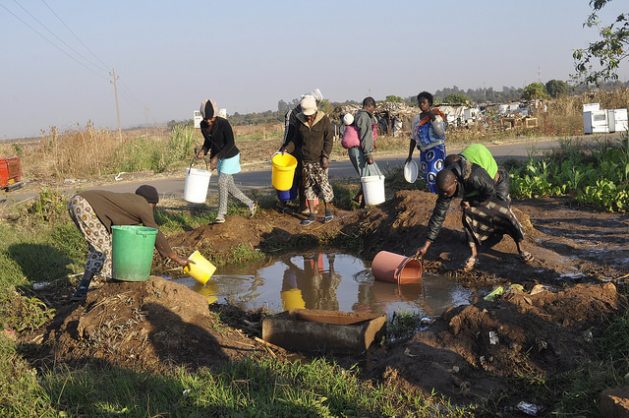Warning: Climate Crisis Is Now the
Single Biggest Health Threat Facing Humanity

This year’s World Health Day launched a new warning: more than 13 million deaths around the world each year are due to “avoidable environmental causes”. Credit: Bigstock
- While the world’s top scientists and experts continue their arduous work to finally submit to politicians at the 27th session of the Conference of the Parties (COP 27) in Sharm El-Sheikh, Egypt (7-18 November 2022), a new alert now emerges: the climate crisis has already become the single biggest health threat to humankind.
But this new alert should be no surprise: it rather constitutes the logic, expected consequences of the more and more intensive pressure of the life-keeping and life-saving natural resources.
No wonder: there are too many chemicals, lead, mercury, microplastics and a long etcetera, poisoning the air we breathe, the food we eat, the water we drink, the oceans, the soil, the forests, the indispensable biodiversity and now also the world’s large reserves of water in both the North and South Poles.
Several of these consequences are visible –though apparently unwanted to be seen: destructive floods, deadly droughts, unprecedented heatwaves, the Earth’s lungs are suffocated, biodiversity is lost. And there is an increased risk of new zoonotic diseases transmitted between animals and humans.
This year’s World Health Day, marked on 7 April, launched the new warning. In fact, the World Health Organization (WHO) estimates that more than 13 million deaths around the world each year are due to “avoidable environmental causes.”
This includes the climate crisis which is “the single biggest health threat facing humanity.” “The climate crisis is also a health crisis.”
The impacts
The world body reminds of the following facts:
- Over 90% of people breathe unhealthy air resulting from burning fossil fuels.
- Polluted Planet increases diseases like cancer, asthma, heart disease.
- A heating world is seeing mosquitoes spread diseases farther and faster than ever before.
- Extreme weather events, land degradation and water scarcity are displacing people and affecting their health.
- Pollution and plastics are found at the bottom of our deepest oceans, the highest mountains, and have made their way into our food chain.
- Systems that produce highly processed, unhealthy foods and beverages are driving a wave of obesity, increasing cancer and heart disease while generating a third of global greenhouse gas emissions.
- Floods can cause poisoning
- Climate change makes wildfires more likely
- Above 40 degrees, heat strokes might happen, causing organ failure and even death
- Wildfires can cause death and injury from suffocation.
- Wildfires can cause trauma impacts on mental health
- Climate change is making floods more dangerous
- Zoonotic diseases – those diseases that can spread between animals and people – continue to have major impacts on human health. Every year, nearly 60.000 people die from rabies, and other zoonotic diseases such as avian influenza, Ebola or Rift Valley fever constitute additional threats.

2 billion people lack safe drinking-water globally, and 3.6 billion people lack safe toilets. Credit: Jeffrey Moyo/IPS
Half of humanity already lives in danger zone
In spite of these and other dangers, the world is visibly doing too little, not to say almost nothing. In fact, the goal to limit future warming to 1.5 degrees Celsius, highlighted in the Paris Agreement on climate change, and driven home in last November’s COP26, gathering in Glasgow, is now on “life support” and “in intensive care,” the UN chief told the Economist Sustainability Summit on 21 March 2022.
The United Nations’ Secretary-General António Guterres highlighted some of the progress made at COP 26 last year but pointing to “the enormous emissions gap” conceded that “the main problem was not solved – it was not even properly addressed.”
Worsening
According to current national commitments, however, global emissions are set to increase by almost 14 percent during the rest of the decade. Last year alone, global energy-related CO2 emissions grew by six percent “to their highest levels in history,” Guterres said, as coal emissions surged “to record highs.”
With the planet warming by as much as 1.2 degrees, and where climate disasters have forced 30 million to flee their homes, Guterres warned: “We are sleepwalking to climate catastrophe.”
“This is madness”
If we do not want to “kiss 1.5 goodbye…we need to go to the source – the G20” (group of leading industrialised nations), the UN chief said.
Noting that developed and emerging G20 economies account for 80 percent of all global emissions, he drew attention to a high dependence on coal but underscored that “our planet can’t afford a climate blame game.”
“Countries could become so consumed by the immediate fossil fuel supply gap that they neglect or knee-cap policies to cut fossil fuel use,” Guterres insisted. “This is madness.”
As fossil fuels reliance continues to put the global economy and energy security at the mercy of geopolitical shocks and crises, “the timeline to cut emissions by 45 percent is extremely tight.”
No cure in sight
In spite of all the feasible remedies indicated by the world scientific community –and the visible effects of the ongoing climate emergency– there is no actual cure in sight.
See what is at stake:
Politicians subsidise fossil fuel with six trillion dollars in just one year. In fact, they have spent such a huge amount –six trillion US dollars– from taxpayers’ money to subsidise fossil fuels in just one year: 2020. And they are set to increase the figure to nearly seven trillion by 2025.
Carbon dioxide is the single most important greenhouse gas in the atmosphere, accounting for approximately 66% of the warming effect on the climate, mainly because of fossil fuel combustion and cement production
There are more lethal gases and fewer, weaker sinks
With one million species endangered, the web of life is at risk of extinction
Half world’s population, exposed to floods, storms, tsunamis, by 2030
The “Kidneys of the Earth” Are Disappearing, as Wetlands, which are considered as a natural solution to the global threat of climate change. They absorb carbon dioxide, help slow global heating and reduce pollution, hence they are often referred to as the “Kidneys of the Earth”. Specifically, peatlands alone store twice as much carbon as all the world’s forests combined
Projection indicate that there will be a severe water stress, absolute scarcity for 2 to 4 billion humans by 2025
Meanwhile, the too harmful march of salt and plastics continue unabated on world soils
And there is another major consequence: millions of humans are attempting to escape the devastating impact of the climate crisis, fleeing their homes as migrants and refugees. What would Europe, the US, do with one billion climate refugees?
Pandemics fueled by climate change
Should all the above not be enough, please also know that the World Health Organization has just launched a global bug-busting plan to prevent new pandemics, which are feared to be fueled by climate change.
The plan is aimed to stop the spread of common, mosquito-borne diseases – known as “arboviruses” – which threaten more than half the world’s population. And the main target of the initiative is four of the most common arboviruses: Dengue, Yellow fever, Chikungunya, and Zika.
The World Health Organization poses some sound questions: Are we able to reimagine a world where clean air, water and food are available to all? Where economies are focused on health and well-being? Where cities are liveable and people have control over their health and the health of the planet?
Up to you to judge!











 Unsplash
Unsplash